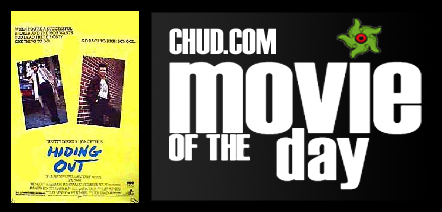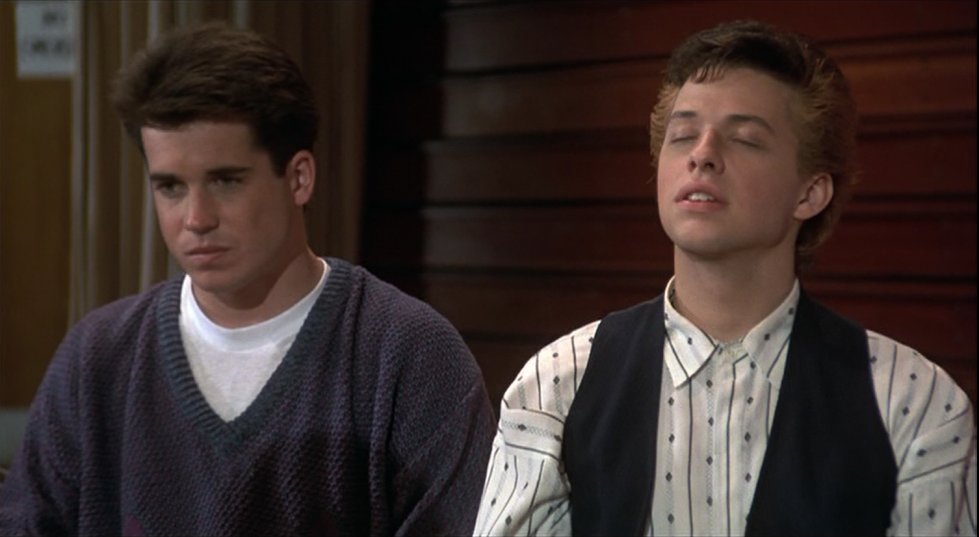The film: Hiding Out (1987)
The Principals: Jon Cryer (Andrew Morenski/Maxwell Hauser), Keith Coogan (Patrick Morenski), Annabeth Gish (Ryan Campbell), Tim Quill (Kevin O’Roarke), John Spencer (Agent Bakey), Oliver Cotton (Killer). Directed by Bob Giraldi
The Premise: Andrew Morenski is a stock broker whose age is extremely hard to determine. He sports a full and glourious beard which may suggest thirties, yet his boyish Duckie face underneath seems to indicate early twenties, tops. Meanwhile his five o’clock foreshadow hints that maybe he could pass for a teenager. But who knows? For the purposes of effectively maintaining the premise of the film, his age is kept relatively vague. And just in time too, as it turns out Andrew and a couple other brokers were inadvertently involved in some illegal brokering with some unsavoury elements of the mobstery type. After one of the brokers ends up dead due to a mob hit, the feds show up to take Andrew into protective custody so he can testify as a witness against the hoodlum he’s been working for – Victor Kapados.
Of course, the feds still hadn’t quite figured out how to effectively protect people by the time the eighties rolled around, so Andrew’s assigned guards are killed. This puts Andrew on the run, forcing him to head towards the only sanctuary he believes he has left – a large police station with lots of cops around to make sure he doesn’t die his aunt’s house. But when he gets there, Andrew discovers that some still-living feds have gotten to his aunt ahead of him in an effort to reacquire him – possibly in an attempt to protect him better this time. Realizing he can pull off the main plot of the film much more effectively on his own, Andrew flees to a gas station where a startling metamorphosis occurs.

“Okay, so it’s one dollar to look at it. Two dollars to touch it. Three dollars to watch me touch it. Five dollars to touch it while I touch my toes.”
“I was just going to give you a sandwich.”
Turns out all those other eighties high school flicks were right – a little bleach, a quick shave, and a change of clothes can make you suddenly look like you’re at the twilight of your pube years. With his new disguise complete, Lenny 2.0 makes his way to the local high school –which is a questionable tactic, as the tagline for the film seems to suggest that it’s more frightening than murder.
Registering himself under the obviously stolen moniker of Maxwell Hauser, Andrew immediately reveals his true identity to his cousin and new schoolmate Patrick. From there, Andrew tries to lay low while the feds and the mob are each out searching for him without somehow running into each other. This gives Andrew plenty of time to accidentally run for class president, begin a highly questionable relationship with a female classmate who is somewhere between 12 and alotta years his junior, become friends with the janitor custodial worker (because it’s a noble profession), and avoid his aunt completely by shacking up in the basement of the high school – basically, all of the things that you would naturally do when trying to hide from everyone out looking for you.
Eventually, the hitman contracted to kill Andrew somehow manages to find him despite the huge trail Andrew left for Stevie Wonder to find. In what turns out as a big surprise to no one, the hitman’s brief moment of competence is immediately invalidated when his attempt to shoot Andrew from the rafters of the gymnasium is thwarted by the janitor academic sanitation engineer (they deserve respect) who revealed earlier, for no reason whatsoever, that he used to be a professional boxer. This allows Andrew to finally face off against his attempted murderer. With the help of his newfound teen friends, his cousin, and the girl he’s going to jail for, Andrew is able to defeat the contract killer by forcing him to fall to his death right where they play basketball.
With the bad guy finally dispatched, and with certainly no possibility that the mob would just send someone else, Andrew does the one thing he probably should have done from the very beginning that could have avoided the whole plot of the film in the first place – he turns himself in to the feds to testify against Kapados and be placed in witness protection. Luckily, the feds are fans of stalking and allow Andrew to be placed where he can attend the same college his finally legal girlfriend is going to. One brief reintroduction later, and this is where I like to pretend that this is actually the origin of Cryer’s character from Two and a Half Men.
Is It Good? I can usually defend most of the eighties films I review beyond just viewing them through a nostalgia filter. Unfortunately, the same can’t be said for Hiding Out. Though I still hold a special place in my heart for this film and enjoy it every time I give it a watch, the truth is that it simply does not hold up. The premise alone is barely functional and requires a major suspension of disbelief in order for it to work. From the start, you have a protagonist whose age is kept intentionally vague. This is done in the hopes that once the comedy and action start taking turns distracting you with flurry upon flurry of weak gags and unnecessary set-ups that you won’t have time to stop and think about the logistics of how it just wouldn’t work for a guy to be that far into a career as a stock broker, be old enough to argue the merits and flaws of Richard Nixon, yet still be able to pass for eighteen and maintain a fake student identity all while flirting with statutory rape simply by applying a fresh coat of bleach.
But the movie worked well enough back in 1987, especially once it hit cable. Hiding Out was released during the late eighties/early nineties as part of a new genre Roger Ebert referred to as the “Generation Squeeze”. At the time, studios were trying to figure out a way to mix adult and teenage elements into the plot so that studios could widen the appeal for theatrical runs, as well as increase the revenue that came from the growing popularity of home video release. As a result, we saw films like Peggy Sue Got Married, Big, and Hiding Out. And they were successful. Movie goers were enjoying the generation clash films like this were delivering to them in varying degrees.
But, like what usually happens when everyone in Hollywood jumps on the bandwagon, what you eventually end up with is a soaked mogwai’s worth of clones all trying to find ways to incorporate the formula in new and creative ways. Sometimes you get films that make the gimmick work, delivering a solid story with decent performances all while managing to transcend said gimmick so that even decades later the movie ends up being just as good then as it was when it was first released.
Sadly, Hiding Out just isn’t one of those movies. When compared against other eighties flicks of similar build, it just doesn’t stack up. Viewed outside of the zeitgeist it was spawned from, this movie immediately loses the lens we’re accustomed to viewing it through. It’s not the movie we remember. It’s simply a movie of its time, trapped there, designed to pander to folks that grew up in that era. Unfortunately, those people have grown up and no longer fall for the man behind the curtain. Meanwhile, anyone who has grown outside of that era would find themselves out of touch with it. And not even the halfway decent performances or even Cryer’s usual charm can save it. Hiding Out is simply a relic of the eighties.
Is It Worth a Look? No. This one’s purely running on nostalgia fumes. There are plenty of better eighties flicks out there that you could be investing your eyeball time in. Hell, there are better Jon Cryer films out there that you should be checking out.

Despite how badly the Hoffcentric Nick Fury telefilm bombed, Marvel moved forward with their next project: a live action adaptation of The Punisher Meets Archie.
Random Anecdotes: Jon Cryer’s real life mother played his aunt in the film. In an odd twist, his aunt ended up getting cast as his cousin Patrick.
Watching this movie led to Roger Ebert wondering what it would be like to revisit his high school years. He immediately gave the idea two thumbs down.
Roy Orbison re-recorded his hit song “Crying” with k.d. lang for this movie. I’m sorry, I can’t do it. That joke’s just too easy.
Cinematic Soulmates: 21 Jumpstreet, Nuns on the Run, Kindergarten Cop, Sister Act, Desperately Seeking Susan

